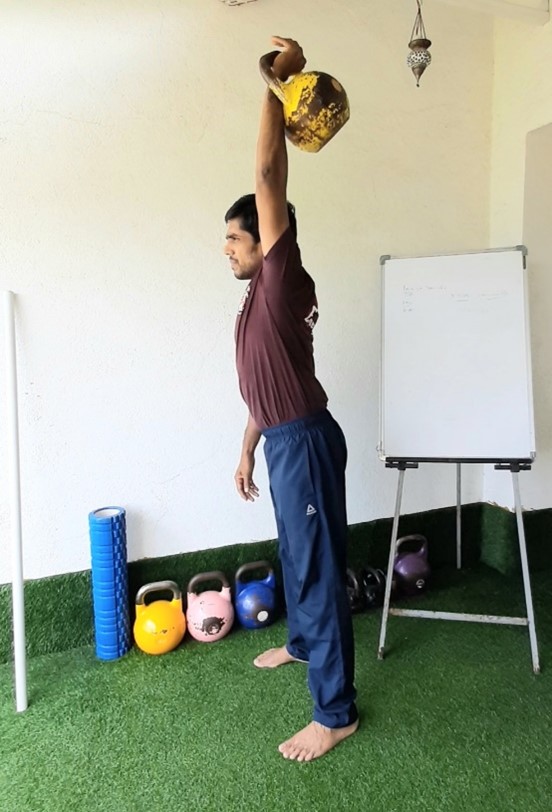Introduction:
Which exercise is superior in the field of strength training, the argument goes, between dumbbell and kettlebell presses? The simple explanation I have always given to this topic, which commonly comes up during my lectures around India, is that these two lifts are different and not simply comparable. In this essay, we’ll explore the specifics that set each one distinctive from the others. Each has its own distinct advantages.
Table of Contents
Understanding Dumbbell Press:
Starting off, let’s examine the dumbbell press in more detail. The humerus bone is parallel to the ground at the start of this exercise. The anterior deltoid, which includes the lateral deltoid (the outer part of your shoulder) and the posterior deltoid (the back of your shoulder), as well as engaging the triceps, is the main target of the dumbbell press. This exercise primarily tries to increase the growth of muscle cells, a process known as muscular hypertrophy.
However, using dumbbells to do a shoulder press involves more than simply these muscular groups. Other muscles participate in the movement at different points to add stability. Making it a complete upper body workout, your trapezius, latissimus dorsi, rhomboids, and other back muscles contribute.
Kettlebell Press: A Different Approach:
On the other hand, the Kettlebell Press has a distinctive methodology, starting with “the clean” in which the kettlebell is stacked on the iliac crest before being raised overhead. Due to its multi-planar dynamic movement, the Kettlebell Press engages a wider range of muscles than the Dumbbell Press. The Internal and External Obliques, Middle and Lower Trapezius, Rhomboids, Biceps, Medial Deltoid, and Triceps are among the muscles used in the Kettlebell Press.
When comparing the two exercises for muscular hypertrophy, dumbbell presses typically win out. The shoulder complex is severely strained by the external rotation and shoulder abduction positions used in the dumbbell press. However, particularly when lifting high weights, this can raise the chance of a pec major rupture. Strength training should always be done with safety as the first priority.
The movement of the kettlebell press, however, is frequently regarded as more practical and organic. As with the dumbbell press, the kettlebell’s cannonball-like offset shape prevents the force from acting directly on the muscle fibers. This balances the stress distribution and gives the exercise a layer of intricacy, making it a great option for anybody wishing to work their stabilizing muscles.
The Key Advantage of Kettlebell Press:
The Kettlebell Press’s effect on the plane of the scapula (POS) is its most important prong. The glenoid (the socket) and the humeral head (the ball) are positioned in the safest and least stressful way possible during arm elevation thanks to the typical resting position of the scapula on the back of the rib cage, also known as the shoulder blade on the back of the ribs. Anyone worried about the health of their shoulders, especially athletes and bodybuilders who frequently lift high weights, can benefit greatly from this natural stability.
In order to avoid injuries while exercising or playing sports, shoulders must be stable. The humerus, the bone that aligns in the socket (glenoid), is relatively small in the shoulder joint, which is frequently referred to as a ball-and-socket joint, as opposed to the hip joint. This size difference may increase the risk of shoulder dislocation and contribute to joint instability.
It is advised to include the “Kettlebell Overhead Hold” exercise in your regimen to improve shoulder stability. Increase the time and load gradually, starting with a 30- to 1-minute hold. Your fitness or strength training program can benefit tremendously from this approach. The objective is to lift a weight that is 4 kg heavier than the amount of weight recommended for training. Consider executing the kettlebell overhead hold with a 24 kg weight before finishing your set, for example, if you are performing a 16 kg dumbbell or kettlebell press or a 20 kg kettlebell press/push press.
In-Depth Analysis: The Battle of Dumbbell and Kettlebell Press:
After examining the Dumbbell Press and Kettlebell Press separately, it’s time for a thorough comparison that delves deeper into the conflict between these two powerlifting behemoths. We’ll look at the effects of each exercise on muscular development, stability, and functional fitness.
- Muscle Hypertrophy and Dumbbell Press:
The dumbbell press is a leader in the field of muscular hypertrophy, or the expansion of muscle cells. A popular alternative for people looking to maximize muscular growth in their shoulders, shoulder abduction and external rotation places a significant demand on the entire shoulder complex.
There is a limitation to this benefit, though. The danger of pec major rupture increases with the increased loading capacity of dumbbells, especially when lifting big weights. Injury prevention requires taking safety procedures.
- Functional Fitness and Kettlebell Press:
Kettlebell Press follows a different path, emphasizing natural movement and functional fitness. Due to the offset shape of the kettlebell, maintaining stability requires the use of a wider variety of muscles. The lifting and pushing of objects with an unbalanced center of gravity may be necessary in real-world situations, which are reflected in this activity.
The Kettlebell Press’s effect on the plane of the scapula (POS) is one of its most notable characteristics. The glenoid (socket) and humeral head (ball) are in the safest and least stressful position during arm elevation because the shoulder blade is resting on the back of the ribs. For those worried about shoulder health and injury prevention, the kettlebell press is a great option.
Choosing the Right Exercise: Goals Matter
Your choice between the dumbbell press and the kettlebell press should be based on your tastes and fitness objectives. The dumbbell press may be the best workout if muscle hypertrophy is your main goal. But safety must always come first, especially when working with large loads.
However, the kettlebell press is a great option if you want to improve your functional fitness, stability, and shoulder health. It prepares you for movements that are required in everyday life and presents your body with fresh challenges.
The Importance of Shoulder Stability
No matter which of these two exercises you choose, shoulder stability is of utmost importance. Despite frequently being referred to be a ball-and-socket joint, the shoulder joint is intrinsically less stable than the hip joint. The shoulder joint is prone to instability and dislocation because of the relatively small bone (humerus) fitting into the socket (glenoid).
Consider including the “Kettlebell Overhead Hold” exercise in your program to improve shoulder stability and lower your risk of injuries. Begin with lesser weights and shorter holds before progressively increasing the time and load. This process has the potential to completely alter your approach to strength training and fitness.
Conclusion: The Battle of Dumbbell and Kettlebell Press
In conclusion, the dumbbell press and kettlebell press are two different exercises, each of which has advantages and uses. While the dumbbell press may be the best for building strength, the kettlebell press has special advantages for shoulder stability and practical movement. Depending on your interests and exercise goals, you can choose between the two. In the end, including both in your workouts can give you a well-rounded approach to developing strength and keeping your shoulders healthy.
Attending EKFA Kettlebell seminars or workshops can provide you with more information on these exercises and strength training, as well as professional advice. Make your knowledge stronger and become kettlebell-strong!
The debate between dumbbell and kettlebell presses is not about which exercise is better; rather, it is about understanding each exercise’s unique benefits and choosing the one that best suits your fitness goals. In order to enhance your strength and well-being, keep in mind that the real battle is within you, whether you’re lifting dumbbells or swinging kettlebells.

